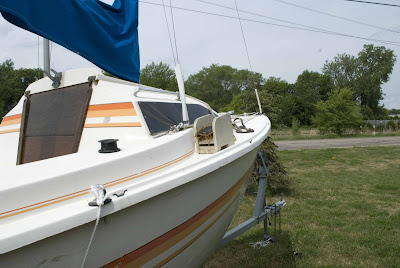When you think IT people, you generally think of someone whose personal interest -- whose life in general, resolves entirely around technology and gadgets. Someone who transitions from an 8+ hour workday tinkering with servers, desktops, phone and business systems to an evening of quite web work and video games. Someone who owns the latest hybrid phone/computer bastardization and is avidly into facebook, twitter, or whatever the latest tech fad is.
That's not me. After over eight years in the IT field, I can tell you that I'm more skeptical of technology than I ever was, and that if given the choice I would rather invest in humans, training, and the refinement of processes than the panacea promises of house-of-cards software and snake-oil gadgets.
That may be why I've always liked the idea of sailing. The first human to mount a reed mat to their dugout canoe discovered an efficient method of locomotion and a technology. Over thousands of years that method has been refined and perfected and has continued to evolve. You could compare that sailing canoe to a 1st rate of Revolutionary times, or a Catalina that's just rolled out of the shop and find the same forces driving it; the simple combination of hull (now largely fiberglass), sail (for a long period canvas, now various synthetics), and human skill.
It's this trust that got me; the trust in a small group's ability to 'reef, knot and steer'; to navigate across enormous expanses of water with a small cache of canvas and just under an inch of oak and tar between them and oblivion. This relationship between human and boat wasn't a romantic one to be sure; quarters were cramped, and history is rife with sailors who fell from icy rigging, were crushed under falling yards, lost arms to gangrene, or died of malaria, scurvy, or yellow jack. It was, however, a relationship that won wars, shaped history and even the words we use today.
Our new vessel; a 19' O'Day DaysailerTo this end, several weeks back, I went to the White Bear Boatworks to look into the purchase of an O'Day 19 (circa 1984), my friend, coworker and yacht racer Jim in tow. Save a few nicks in the paint, and a cabin window that could use a little caulk, she was in extremely good shape, and came with a trailer and 6hp outboard at a good price. Bought her the same day.
My wife wasn't terribly surprised when I came home to tell her we'd purchased a boat. Sailing has been something I've been thinking about doing for the past twenty or so years, and something I'd been thinking seriously about investing in for the past five. My father and I had purchased plans for a 16' rig, and we'd even taking some very basic sailing courses at the North House Folk School up in Grand Marais.
As I said, we'd purchased her for a very reasonable amount, and my parents wanted to go in half, as we'd be trailering it up at their place (in the Brainerd Lakes region) anyways. We've sailed her a grand total of once so far; a brief trip with Jim around White Bear Lake so that my wife and I could get a handle on the very rough basics of rigging, tacking, jibing, and steering. We did embark on one adventure before that, but the outboard got so choked with weeds on leaving the White Bear marina, and Jim was so concerned about making sure there was nothing wrong with it, that we didn't get further than the docks.
The mast has since been lowered, and the boat trailered back to Brainerd for maintenance and outfitting. So far, we've purchased:
- Toolbox
- Locking pliers
- Needlenose pliers
- Crescent Wrench
- Wire snips
- Scissors
- Screwdriver
- Pry bar
- Caulk
- Marine Glue
- Duct Tape
- Dacron Tape
- Various multitools and knives
- Flashlight
- Lighter
- Various spare hardware and lengths and gauges of wire
- First aid kit
- Mallet
- Bower (main anchor)
- 50' of anchor line
- Spare paddle
- 4 lb machining hammer
- Anchor
- Hatchet
- Ladder (wasn't one to get on to the boat)
- Various spare ropes
- Fenders
- Ponchos
- Life jackets
And thrown in various lengths of spare halyard, dockline, and chain, shop cloths, and spare shop and beach towels. The boat came with a basic emergency kit of flares, though many of them are bad and in the process of being replaced, and a name (won't put it here for fear of offending the old owners), which is so difficult to pronounce that we're also in the process of replacing in a rechristening ceremony to be determined this weekend. The list of potential names so far include the
Otter,
Merganser,
Springtide,
Midgard,
Esmerelda, and
Fenris.
This blog is to serve the purpose of a sort of apprentice sailor's diary, as well as to serve up any information that could serve as a point of illumination/warning to anyone else just picking up the craft.







